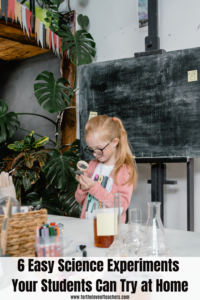
Now that online learning is becoming more popular and common, teachers are finding new ways to recreate classroom activities at home. For science teachers, this means creating fun hands-on experiments for students to do in their own time or during an online class. Online science classes for kids give students the opportunity to perform these experiments so they can get excited about science and develop an appreciation for it. Here are some great science experiments that your students can try at home.
1. Bubbles
Bubbles are a fun experiment to teach students about pressure, volume, temperature, and density. All they need is a small jar, water, dish soap, and a straw. To do this experiment, have your student blow through the straw into a jar full of dish soap and water. The bubbles should pop as soon as the air comes out of the straw.
After the experiment, ask your student questions like, What caused the bubbles to burst? Did the bubbles change size? How did blowing harder affect the amount of air inside the bottle?
2. Water Cycle
This is another experiment that’s perfect for teaching students about the water cycle and how water moves from one place to another. For this experiment, ask your students to fill a bowl with cold water. Then, put a lid (such as saran wrap) on top of the bowl and leave it somewhere outside where there is direct sunlight. In just a few hours, the water will evaporate and cause condensation. When the condensation occurs, it will drip down onto the ground. Have your students observe what happens when the water drips off the lid.
After the experiment, you can discuss the following topics: Why are there water droplets on the lid? Where did the water drops go after they drip off? Why was it important for the water to move from the inside of the bowl to the outside?
3. Homemade Volcano
The classic volcano experiment is a great way to teach your students about acids and bases. You’ll need baking soda, vinegar, and food coloring. Ask your students to mix equal parts of water and baking soda together. Once mixed, pour the mixture into a container (or even ask them to make a volcano set up). Afterward, add enough vinegar and food coloring to the mixture. Let your students observe what happens next.
After conducting the experiment, ask your students how the vinegar affected the baking soda mixture. Discuss how adding different amounts of vinegar affect the mixture and why this happens. This lesson will also help students understand what acidity is and its importance in chemistry.
4. Hot and Cold Water
This simple experiment teaches students about the density of hot and cold water. To do this experiment, ask your students to get two cups of each type of water—hot and cold. Then, use food coloring to mark the hot and cold water. Afterward, ask them to combine both kinds of water in a transparent glass jar. They should notice that the colors tend to separate in the glass jar.
The hot and cold water teaches students to recognize which liquids are denser than others. It also teaches them that heat rises and cold sinks. You can ask them questions like, Which color tends to stay at the bottom? Why do you think this happened? Why is it important to know the difference between hot and cold water?
5. Rubber Band Guitar
If you want to teach your students about sound and acoustics, then the rubber band guitar is an excellent experiment. The experiment involves simply stringing rubber bands across the hole of an empty tissue box. Make sure to ask them to place different thicknesses of rubber bands as well. Afterward, have them play the instrument by hitting or strumming the rubber bands. Ask them to play individual rubber bands and observe the differences in notes they produce.
After this experiment, you may want to discuss the following topics with your students: How does the size of the rubber band affect the note produced? Why does the pitch increase when the rubber bands become thinner? How could you adjust the tone of the instrument?
6. Germinate a Bean
When it comes to teaching students about plant life, germinating a mung bean is probably one of the easiest experiments. For this experiment, your students will need some mung beans, a damp paper towel, and a spray bottle. Tell your students to place the mung beans on top of a damp paper towel near a source of sunlight. Ask them to record what happens to the beans in a span of two weeks.
This experiment will allow your students to see how plants grow under natural conditions. You can also ask them various questions such as: What changes did you notice after observing the plants for two weeks? Do you think there are any other things that can influence the growth rate of the plant?
Final Words
Online learning doesn’t have to be boring. In fact, there are different ways you can make online learning more interactive and fun for your students. You can even utilize several online resource kits for an easier teaching experience. With the right set of tools, you can make your online science lessons engaging and memorable for your students.
About the Author: Bash Sarmiento is a writer and an educator from Manila. He is currently finishing his Doctor of Education degree in Miriam College. Bash writes laconic pieces in the education, lifestyle, and health realms. His academic background and extensive experience in teaching, textbook evaluation, business management, and traveling are translated in his works.
Thanks for reading!
If you like it, then pin it!



Christine Weis is a passionate educator, classroom management coach, wife, and mom of two busy boys. She enjoys teaching, writing, and creating resources for teachers.




The homemade volcano is always a hit! Thanks for sharing. I am going to try germinating a bean next.
Hhhhmmm…I would love to try out the home-made volcano. I don’t think I have seen it before. Thanks for sharing about these.
We have done a couple of these. Nothing beats a homemade volcano for making the littles excited.
These experiments are fun and cool to do with the kids. Experiments are a great way for the kids to expand their imagination and creativity or just have some fun in the house. Hot and Cold Water is simple to do but fun.
I remember doing a volcano experiment at home when I was a kid during school breaks and it was so fun. This reminds me of how enjoyable it was and I would like my kids to experience the same.
My hsuband is the fun parent and loves to do these with the kids.
These are some great ideas for those hot summer days when the kids stay inside! thanks for sharing 😀
Wow! These are all really amazing experiments! I know my kids would definitely enjoy doing these!
These science experiments would be great for home schoolers. Kids would love these.
Simple science experiments like these are such a great way to get kids excited about STEM. I think these are great ideas.
I love doing experiments at home with my boys. The hot and cold water one will actually go perfect with one of the Cub Scout badges I have to do with my scout den this year!